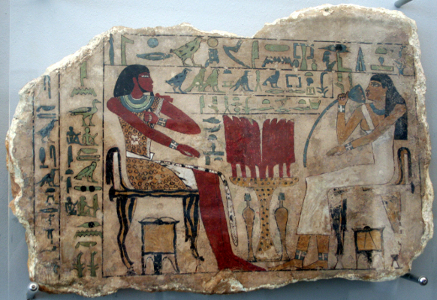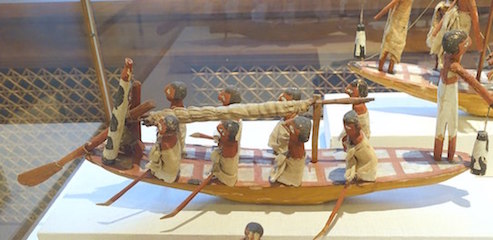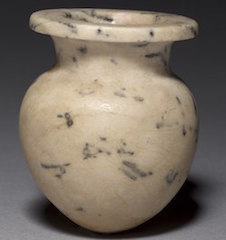The First Intermediate Period was popularly described by historians as a “dark age”. However, this has begun to change in recent times. Manley suggests the First Intermediate Period should instead be referred to as the “Era of the Regions” and Kemp characterises it as a “loss of equilibrium between a powerful court and provincial aspirations”.
In 1971, Posner commented that the First Intermediate Period “brings misery, insecurity, and restlessness” and proposed that “Messianic literature came into being in the First Intermediate Period when men had need of hope”. However, it is now generally agreed that the messianic texts referred to were composed during the Middle Kingdom and therefore the political motivations of their authors must be considered. For example, “the Prophesy of Neferti” compares the “national distress” of the period before the ascension of Ameny (generally agreed to be Amenhotep I) to the peaceful prosperity of his reign. However, it is debatable whether the text can illuminate the First Intermediate Period at all. Montuhotep Nebhepetre re-established centralised control over unified Egypt some time before the rule of Amenemhat I and there is no evidence that there was any turmoil in the run up to his reign. Lichtheim persuasively argued that the text is “a historical romance in pseudo-prophetic form” the purpose of which was to legitimize Amenemhat’s rule.



Lichtheim characterises the First Intermediate Period as a “brief interlude of local autonomy” and comments that earlier historians were beguiled into accepting the negative portrayal of the period by Middle Kingdom texts, in particular the “Admonitions of Ipuwer”. Gardiner suggested that this text confirmed the chaotic nature of the period which he attributed to the “machinations of lowborn adventurers and Asiatics pushing their way into the Delta”.
Gardiner recognises the fact that the text may be the work of a “Die hard aristocrat” but still asserts that the reliability of the text as a depiction of the First Intermediate Period is “indisputable”. In contrast, Lichtheim suggests that this text is simply a further example of Middle Kingdom fiction on the subject of “national distress” which should not be taken literally.
The tone of the above texts is decidedly pessimistic and none of them actually claim to be set in the First Intermediate period. Conversely, contemporary texts are optimistic describing “crisis brilliantly overcome” (Seidlmayer).
For example, the local nomarch Ankhtify claims rather dramatically that “all of Upper Egypt were dying of hunger and people were eating their children, but I did not allow anybody to die of hunger in this nome” while Merer of Edfu states “I buried the dead and nourished the living, wherever I went in this drought which has occurred” and Iti notes “I nourished Imyotru in years of misery”

Bard suggests that these claims were “standard rhetoric” for tomb biographies but confirms that they may also reflect the reality of poverty and hardship. Similarly, Manley comments that the statements are coloured by “personal interests and the conventions of writing” but were probably at least partially true. Seidlmayer questions whether the threat of famine was specific to the First Intermediate Period and argues that the prominence of famine and disorder in contemporary texts owes more to the desire of officials and rulers to display their high moral standards and show that they cared for the people in order to legitimise their own position. Ankhtify, Merer and Iti all adopt a paternalistic attitude to their provinces and to some degree take on the duties which would previously have fallen to the king, and so Lichtheim concludes that the social hierarchy still functioned albeit on a more local level.
The “Teaching of Merykara” would appear to support the reference to Asiatic incursions in the Delta mentioned in “Admonitions”. However, while Gardiner was clearly convinced that these two texts confirmed the threats to Egypt’s borders, Seidlmayer comments that again this text was probably composed during the Middle Kingdom and states “there is no independent evidence that Asiatic immigration was a problem”. Kemp notes that the text should only be used as a historical source with caution. However, Lichtheim does consider the work to be contemporary and to contain genuine historical information. This may well be the case as it is notable that despite reference to rebellion and warfare, the text is rather optimistic and generous in demeanour and does not share the gloomy negativity of the Middle Kingdom texts mentioned above.
There is contemporary reference to military activity and Seidlmayer notes that once the Theban rulers grew in power there were sporadic bouts of warfare for several decades before the final blow was struck. However, he also proposes that this conflict was “localised and short-lived”. Gardiner accepts that there may have been areas of relative calm, but it is interesting that he dismisses the claim of a ship’s captain that he sailed to Elephantine on the king’s business as being “impossible” purely because of his view of the chaotic and dangerous nature of the period.
The absence of the monumental funerary architecture strongly suggests that the Egyptian state was fragmented “both in its political organization and its cultural patterns”, and that the resources of Egypt were no longer under the control of the centralised state. However, this is now seen as a shift of emphasis away from the capital and the monuments of a single ruler to a wider and more diverse spread of building works. The rulers and nobles of Upper Egyptian states sought to display their power and wealth by constructing decorated tombs. Distinctive artistic and architectural styles developed in different regions , for example, the “saff tombs” of the Theban princes and the enigmatic mastaba at Kom Dara. The Theban ruler Intef II built a large number of temples for local gods and while no monuments have been definitively attributed to Herakleopolitan rulers, this may in part be due to the comparative lack of archaeological investigation of their territory.
There was a marked increase in the quantity and size of low and middle status burials in provincial cemeteries in Upper Egypt. Even lower status burials often included valuable items many of which were for everyday use (suggesting wider access to luxury goods which would tend to contradict the characterisation of the period as stricken by poverty). Van de Meiroop suggests that “even the modestly well-off had sufficient assets to pay for grave goods especially made for the purpose”.

There was a reduction in the status of the burials in the Memphite cemeteries, but this simply brought them in line with those of other provincial towns. Thus, although earlier archaeologists compared these burials to the richer Old Kingdom tombs and concluded that there had been some form of social revolution, this could also be seen as a return to “comparative normality”.


Contemporary sunken relief carving is often crude and sometimes clumsy and ugly. This too has been considered as evidence of cultural decline but as Aldred notes “what this local art lacks in quality, however, it often redeems in liveliness and originality” as scenes of everyday life are imbued with more humour and less formality. Furthermore, the workshops of the Theban rulers began to develop their own impressive style characterised by rounded modelling with a contrast between plain surfaces and intricate carving, while the workshops of Herakleopolis maintained the traditions of the Old Kingdom, but on a smaller scale, so it would certainly be an overstatement to suggest the period lacked artistic merit.
In Upper Egypt the traditional “ovoid” pottery was replaced by more “baglike” shapes which were considered by some to be evidence of a decline in standards. However, this form of pottery was easier to produce en masse and was an obvious development following the introduction of the potter’s wheel which had only been restrained for so long because of the tendency of the centralised state to maintain traditional forms.
Modern historians have increasingly moved away from describing this period as a “dark age” and now recognise that, as well as being a period of warfare and upheaval, the relaxation of centralised control resulted in diversity and innovation and allowed a wider spectrum of Egyptian people to make their mark. While there was no doubt hardship and strife, there was also optimism, ambition and a sense of local pride which resulted in artistic, linguistic and cultural innovations adding to the vibrancy of Egyptian civilisation.
Bibliography
- C. Aldred (1996) Egyptian Art pp.106-112
- K. Bard (2008) An Introduction to the Archaeology of Ancient Egypt pp.162-166
- A. Gardiner (1961) Egypt of the Pharaohs pp.107-129
- B. Kemp (2005) “Old Kingdom, Middle Kingdom and Second Intermediate period” pp.112-116 in Ancient Egypt; a social history edited by Trigger et al
- M. Lichtheim (2006) Ancient Egyptian Literature pp.83-197
- B. Manley (2003) Seventy Great Mysteries of Ancient Egypt pp.228-231
- B. Manley (1996) The Penguin Historical Atlas of Ancient Egypt pp.22-30
- G. Posner (1971) “Literature” pp.220-257 The Legacy of Egypt edited J.R. Harris
- G. Robins (1997) The Art of Ancient Egypt pp.80-89
- S. Seidlmayer (2003) “The First Intermediate Period” pp.108-136 of Oxford History of Ancient Egypt edited by I Shaw
- M. Van De Mieroop (2011) A History of Ancient Egypt pp.80-96
Copyright J Hill 2012